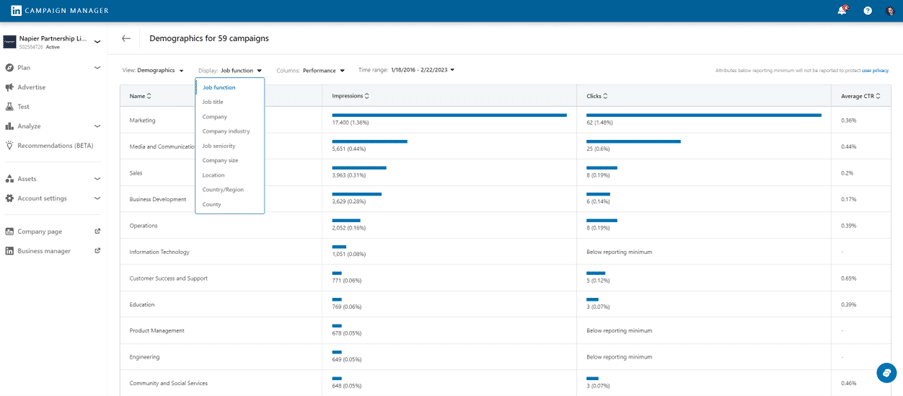If you are running B2B LinkedIn advertising campaigns, you’ve probably realised that the more targeted you can be, the better the results. Although LinkedIn will encourage you to open up your criteria to make the audience large – and therefore boost LinkedIn’s revenue – generally the ability to target exactly who you want to communicate with is the superpower of this important advertising platform. We see many very small campaigns that are often around the minimum audience size deliver phenomenal results with almost negligible budgets.
There are some downsides to more precise targeting: the cost per click, impression or acquisition will increase. Furthermore, companies often want to target a similar persona, so there tends to be greater competition as you focus your campaign more tightly. This shouldn’t be a surprise – the average cost of running an advert to everyone working in, say, the retail industry in the UK should be less than targeting only CIOs in this sector.
Although job function can be useful, it’s pretty broad. So we typically work with clients to target specific job titles. But it’s important to understand that job title is not an exact match: LinkedIn groups job titles so you need to be very careful to make sure you are hitting the right people for all of your campaigns.
The LinkedIn Job Title Matching Algorithm
Let’s be clear about the problem: if you put a job title into an audience definition for an ads campaign your ad will be shown to people who have different titles than the one you enter. LinkedIn is trying to get related job titles, but sometimes it just goes wrong.
Let’s take a really simple example at first. Assume we have a campaign that is designed to target engineers. So we put in “engineer” as one of our job titles. That’s got to be an approach that will generate a technical audience, right? Wrong!
If you enter “engineer” as a job title, LinkedIn will also match “sales engineer” and “field sales engineer” amongst many other job titles. You’ve now got a campaign that is targeting a sales audience rather than your technical audience (in this case it’s not unusual to find more salespeople who see the ad than those who are “real” engineers).
So clearly broad job titles can be bad, as the same word might be used in unrelated job titles. But it’s more complex than that. Let’s consider a recent campaign we ran for a client that aimed to target people who were involved in production or managing sustainability. Here are the job titles we used initially in the campaign:
Looks pretty good, right? So why was it that when we reviewed the campaign 6.2% of the audience had a job title of office manager and 2.3% sheet metal worker?
Before you start panicking and cancelling all your LinkedIn ads, let’s take a breath and be realistic. These two non-matching job titles represent less than 10% of the audience. When we looked, we could see that the campaign was actually working quite well: 90% of the audience fitted the personas we wanted to target.
So this is different from using engineer and finding that you get a large percentage of your audience working in sales. It’s much more typical of the campaigns we see – a smallish percentage of your audience just feels wrong.
You’ll never get a completely perfect audience, so maybe 10% mistargeting is acceptable: after all, it’s probably way better than the targeting you get when running display ads in an online publication. However, there are things you can do to improve your targeting.
Demographics: Possibly the Most Powerful Feature for Optimising LinkedIn Targeting
If you are not using the demographics feature in LinkedIn, you are really missing out. This is a feature that lets you see where your advert is being shown and who is engaging and can be used at the account, campaign group and campaign level.
When you click the demographics button, you’ll see the breakdown of the audience by job function. This is a great overview: if you have a campaign targeting an engineering audience and you see that there are a significant number of people with a sales job function you know something is going wrong.
If the job functions look reasonable, then you can select job title from the drop-down. This is where you can see the main job titles you are targeting. We’re going to show you some results from a set of test and training campaigns Napier has run – they show the points well although the values for CTR, etc are probably not representative of what you should be seeing in your campaigns.
The breakdown by job function will quickly show you if you are hitting the right audience or not. If you take a look at the example below, you can see that Napier’s campaigns have done a pretty good job of hitting people in marketing, communications and PR. So we don’t have to worry about changing the audience to better target the people we want to reach.
Note that where you have a low number of clicks, LinkedIn doesn’t report the data, so if you are running very targeted campaigns, you might be limited in what you can see.
The report can also show you the likely level of engagement: if you look at the top two lines you’ll see that Marketing Directors have a 0.25% CTR, whereas Global Marketing Managers engage at more than double this CTR. This could be caused by a number of factors: the content could be more relevant to the Global Marketing Manager, they could have been targeted by different campaigns (note here that the numbers are spread across a large number of campaigns) or directors could simply be less likely to click. Whatever the reason it’s important to understand why you are getting such a low CTR and, if possible, address the problem.
Tips for Getting Better Job Title Matches on LinkedIn
If you look at the job title demographics and see there is a problem, there are a number of ways to fix it. The first stop is always the pesky audience expansion checkbox: if your audience has the checkbox enabled, then LinkedIn is going to match much more broadly. If you have a clearly defined audience, it’s usually best to ensure this checkbox is not ticked.
You then need to look at the job titles you have entered. Which one do you think is triggering the erroneous match? Perhaps you can remove or replace it with more specific job titles. Sometimes, however, it can be hard to even understand what is causing the unwanted match, and even harder to get a better job title.
Of course, what we would like is to have an audience defined by job titles and job function – in the example of engineer matching with sales engineer having an additional job function filter would let us eliminate people in sales. But LinkedIn doesn’t allow job function to be used in conjunction with job title. Annoying!
There are, however, different filters that might help to eliminate the spurious matches. You can combine field of study in the education section: it’s great if your audience needs to have a degree in a particular field, such as engineering. You might also want to use skills, group membership or interests as filters, although they can result in some LinkedIn members you want to target being eliminated.
Often negative filters are better than positive: for our example where engineer also targeted sales engineers, you could include people with engineering skills/interests, or you could choose to eliminate people with sales skills or interests.
Getting the perfect audience is going to be an iterative process on LinkedIn. Because the matching isn’t exact, you will have to try different things to get the result you want.
Don’t Overthink LinkedIn Audiences
Although you can spend a lot of time tweaking the definition of an audience to get the results you want, it’s important to make sure you’re not wasting your time. For example, if you are running a campaign that is getting 100 clicks at £5 CPC per month, and 5% of the audience is not what you want, that only represents a cost of £25 per month. If it’s easy to fix the problem, it’s worth doing, but a senior marketing professional wasting hours trying to improve this probably isn’t a good use of their time.
Getting LinkedIn Audiences Right
This blog post has hopefully given you some ideas of how to monitor the targeting of your LinkedIn campaign and some ways to make future campaigns more precise in the people they reach. It’s important to optimise for audience as well as results on LinkedIn – as we saw earlier optimising our marketing campaigns to increase CTR might actually result in a campaign that simply targets more junior people. Being able to know information about the people viewing and engaging with your LinkedIn ad campaign is one of the platform’s superpowers, and you should ensure you always use this when optimising.
If you would like more information or a review of your LinkedIn campaigns, please get in contact with Napier via the form below – we’d love to help you out!
Get Help with LinkedIn
Author
-
In 2001 Mike acquired Napier with Suzy Kenyon. Since that time he has directed major PR and marketing programmes for a wide range of technology clients. He is actively involved in developing the PR and marketing industries, and is Chair of the PRCA B2B Group, and lectures in PR at Southampton Solent University. Mike offers a unique blend of technical and marketing expertise, and was awarded a Masters Degree in Electronic and Electrical Engineering from the University of Surrey and an MBA from Kingston University.
View all posts






Great article! I completely agree that precise targeting is key to achieving great results in B2B LinkedIn advertising campaigns. It’s interesting to learn about the LinkedIn Job Title Matching Algorithm and the challenges of matching job titles to the right audience. The demographic feature seems like a powerful tool to optimize targeting and improve campaign performance. Thank you for sharing these tips and insights – I’ll definitely keep them in mind for my future LinkedIn campaigns!